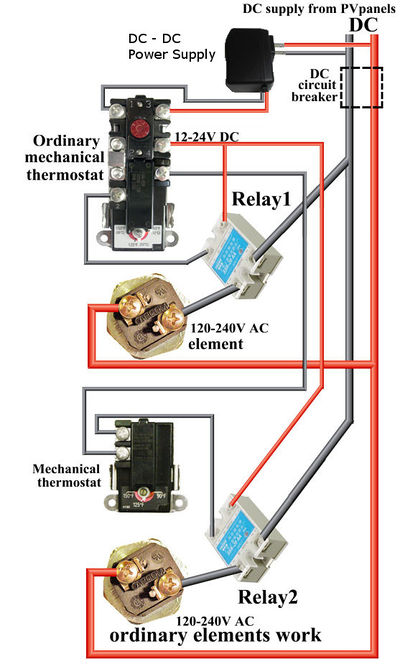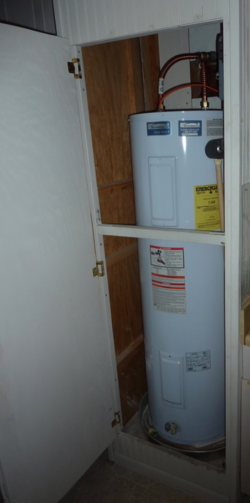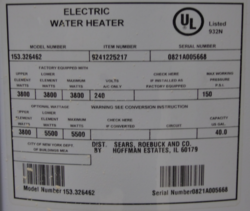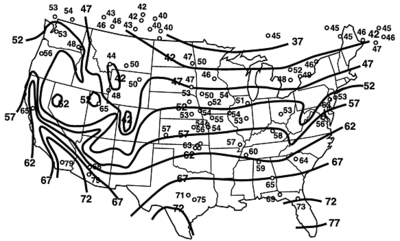SolarWaterHeater
Objective
This solar water heater project employs electric commercially available solar panels to collect sun energy and heat water in a conventional electric hot water heater.
The solar panels are conventional solar panels generating DC electricity and the water heater is a commonly available unit normally powered by household AC electricity.
Design
Most electric hot water heaters for household use heat water using a resistive heating element immersed in the water and a simple bi-metallic thermostat. In the United States, they are usually powered by either 120 VAC or 240 VAC. The thermostat usually employs a bimetallic strip with electrical contacts to interrupt the electricity once the desired temperature has been reached and establish electricity flow when the water temperature drops below a threshold.
Tall water heaters often employ two heating elements and thermostats to heat the upper and lower sections of the tank. Shorter water heaters usually have only one heating element.
I found some documentation about running hot water heaters from solar power on this web page:
Convert AC hot water heater to DC
This is the schematic for a two-element water heater (a single element water heater would use only the top part):
IMPORTANT: The thermostats are not rated for DC and will be damaged if DC voltage is applied! To solve this, we must use a Solid State Relay (SSR) to control the DC power to the heating element. Note that the schematic uses a DC-DC power supply and two Solid State Relays (SSR). This arrangement puts only low voltage / low power to the thermostat so it is not damaged.
First, calculate the resistance of the hot water heater heating element, then the solar supply voltage to match this resistance and finally, the number of panels necessary for heating the water.
UPDATE May 16, 2016: I purchased two 10Amp SSRs, heat sincs and thermal grease and assembled them as shown in the drawing above. It worked well for a couple of weeks, then one of the SSRs quit working with output always closed (bad failure for this application). Now, I have ordered 25 Amp replacements.
Test Case
The Unit used for the initial testing is a Kenmore Power Miser 6 with the following specs:
Capacity: 40 gallon Rated voltage: 240 VAC Rated Power: 3800 Watts
The solar panels are Sanyo
24 VDC 230 Watts
The test design is as follows
Water heater resistance:
Power = Voltage * Current (P = E * I) => I = P/V R = E/I = E/(P/E) = 240 Volts / (3800 Watts / 240 Volts) = 15.1 Ohms (Close: It measured 16 Ohms)
Max solar panel power output:
230 Watts 24 Volts 9.5 Amps
Calculate the number of series connected solar panels to match the load at 9.5 Amps:
Supply voltage = R * I = 15.1 * 9.5 = 143.45 Volts #panels = Supply voltage / Panel voltage = 143.45 / 24 = 5.9 Panels
6 panels at max output produce
6 * 230 W = 1.380 kw
The average water temperature will be the same as the ground temperature, as shown in this illustration:
Calculate the energy required to raise 40 gallons of water from the Dallas ground temperature (67 degrees F or 19.5 degrees C) to the hot water temperature (125 degrees F or 51.6 degrees C):
40 Gallons = 151,416 cc
energy to raise temperature by 51.6 - 19.5 = 32.4 degrees C:
1 calorie * 151,416 * 32.4 = 4905878 calories or 20539930 watt seconds or 5.705 kwh
Use the power figure above for the 6 panel array to calculate the time required to heat the water:
5.705 kwh / 1.380 kw = 4.134 hours
Summary
All the theory sounded good, but the results are what counts. I connected the solar power to the hot water heater and left it running all day on March 26th and in the evening, I had a shower in piping hot water.
Now, that's results.



